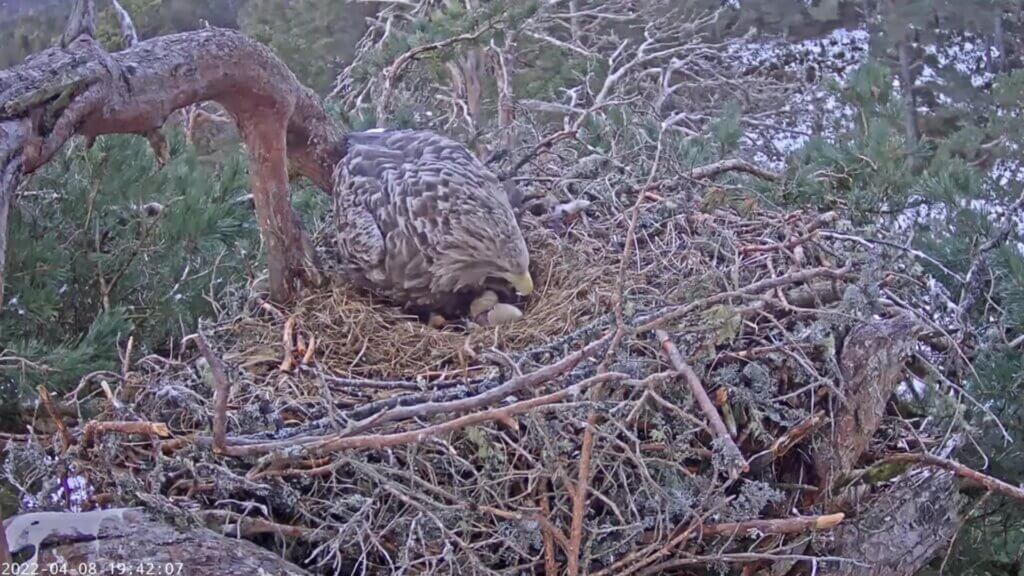
Visitors to RSPB Scotland’s Abernethy nature reserve have enjoyed the first ever live footage of a wild white-tailed eagle hatching in the UK.
The young eaglet is the offspring of Shona and Finn, a pair who are nesting in the vast landscape of the Cairngorms Connect partnership, of which RSPB Scotland is part. Since eggs were first seen in the nest on Thursday 3 March, both parents have shared incubating duties, including protecting them from snow and recent storms, before the first egg hatched at 19:43 on Friday 8 April.
The birds’ activities are being beamed live to the Loch Garten Nature Centre, via a camera which has been hidden in a stick 3 metres from the nest to avoid disturbing the birds. This is the first time such a method has been used in the UK after successful trials in Latvia and Estonia.
Fergus Cumberland, Visitor Experience Manager for RSPB Scotland, said, “The response to the eagles from the public has been one of excitement and anticipation. The true character and personalities of these birds are on full display for the public to experience and it is a wonder to watch it all unfold. Now to see that they’ve hatched their first chick is incredible. We feel so privileged to have been able to witness such a special moment.”
Also known as sea eagles, white-tailed eagles are the UK’s largest bird of prey with a wingspan of 2.5 metres. They were driven to extinction in Scotland in 1918 before birds from Scandinavia were re-introduced to the Isle of Rum in 1975. Subsequent re-introductions in other parts of the country, as well as the birds’ natural dispersal means there are now populations spread as far as Fife, Orkney and the northwest Highlands.
The newly hatched chick is a descendant of these re-introduced birds. Their father, Finn, is the great-grandson of the well-known Skye and Frisa pair of Mull Eagle Watch and BBC Springwatch fame. Skye is the oldest known white-tailed eagle at 28 years old and Frisa was the daughter of Blondie, the first eagle to successfully raise a chick in 1985 after the re-introduction.
After hatching, white-tailed eagle chicks generally remain in the nest being fed by their parents for approximately 12 weeks. Even upon fledging, they remain close to the nest and dependent on their parents throughout the autumn before seeking their own territory.
Jess Tomes, Abernethy Site Manager for People at RSPB Scotland, said, “The next two weeks are critical for this young eagle as they are unable to regulate their own body temperature for the first few days and are totally dependent on their parents to shelter them from the worst of a Cairngorms spring. It’ll be a very tense time for all watching but we welcome everybody to visit us at the Nature Centre and experience these incredible moments!”
To avoid disturbance of the birds, the exact location of the nest is not being disclosed to the public. Visitors to RSPB Scotland’s Loch Garten Nature Centre can view the live feed daily throughout the spring and summer. Highlights and updates will be provided on the RSPB Loch Garten Twitter and Facebook pages.
The camera and live feed have been installed by Wildlife Windows and funded by the European Regional Development Fund through NatureScot.
ends
[registration_form]
Fantastic, great news. The parents have done brilliantly since last time I saw pictures of them incubating on the nest they were covered in snow. Hope now according to the weather forecast it is due to become milder next week without being too wet even in the Cairngorms and Abernethy, so that should help them
. Very great stuff RSPB. and Parents.
Let’s hope before too long there will be a pair of WTEs nesting not too far from Mr Loder’s residence in Dorset which would need to be guarded night and day. Such a situation would really be “ one in the proverbial eye” for him.
I have now read Roy Dennis’s report of the death of the White Tailed Eagle in Dorset. It is very worrying. The bird died of after being poisoned by this very toxic rodenticide. Whether the poison was deliberately set for the bird or whether it accumulated the poison through scavenging dead animals containing the poison is not certain..
The EU regulations do not allow this horrible poison to be used “externally” ( I presume this means outside”) but true to form Defra have recently relaxed these regulations. This is very worrying as this raises the vision of a repeat of the near extermination of what were the main species of vultures in India. This scenario is now a real threat to birds of prey in this country.
How can this Government relax regulations on this really horrible poison? It should not be obtainable anyway. It must have been consumed by the Eagle “externally” in one way or the other. This therefore opens the door to many other animals including dogs and cats, inadvertently being poisoned.
This outfit Defra just beggars belief as to the abuses for which they are directly or indirectly responsible and allow to continue. They are an organisation that should be totally and completely replaced by much more intelligent, competent and reasonable people.
It would be nice if the general public could access this, as many other live feeds – Peregrine etc:, but i suppose it is good for tourism in the immediate area.
SNP want to cull them
What, tourists ?.